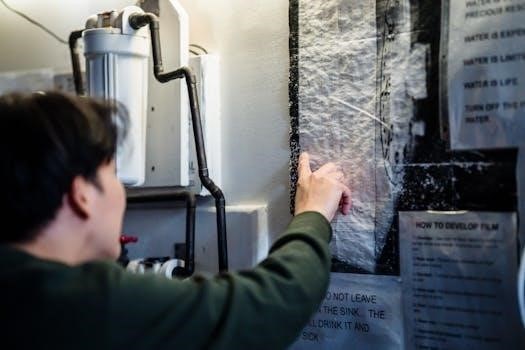Article Plan⁚ Understanding Celsius WG Instructions
This article provides a comprehensive guide to understanding Celsius WG instructions. We’ll explore its purpose‚ key components‚ and safe usage. Furthermore‚ the correct application‚ storage‚ and disposal methods will be detailed for optimal results.
Embark on a journey to understand Celsius WG‚ a powerful tool in turf management. This introduction sets the stage for a deeper dive into its intricacies. Celsius WG isn’t just another product; it’s a carefully formulated herbicide designed to tackle a broad spectrum of troublesome weeds that can mar the beauty and health of your lawns and landscapes.
Specifically crafted for warm-season grasses‚ Celsius WG offers a selective approach to weed control‚ meaning it targets unwanted plants while leaving your desired turf relatively unharmed when used according to the label. This selective action is crucial for maintaining the integrity of your lawn while effectively eliminating competition for resources like sunlight‚ water‚ and nutrients.

Its water-dispersible granule (WG) formulation ensures easy mixing and application‚ making it a user-friendly option for both professionals and homeowners. But before you start‚ understanding the product is paramount for achieving optimal results and ensuring safety. Join us as we unravel the details of Celsius WG and its instructions.
What is Celsius?
Celsius‚ in the context of turf management‚ refers to a specific herbicide renowned for its efficacy in controlling a wide variety of broadleaf and grassy weeds. It’s a systemic herbicide‚ which means it’s absorbed by the plant’s foliage and translocated throughout its system‚ leading to complete weed control‚ including the roots. This is important because it prevents regrowth.
The active ingredients in Celsius typically include a blend of compounds‚ each contributing to its broad-spectrum activity and effectiveness. These ingredients work synergistically to disrupt essential plant processes‚ ultimately leading to the weed’s demise. The specific formulation and concentration of these active ingredients are crucial for its performance and selectivity.
Celsius stands out due to its ability to control weeds in warm-season turfgrasses without causing significant damage to the desired turf‚ when applied correctly. Understanding the “what” of Celsius is fundamental before delving into the specifics of Celsius WG instructions‚ ensuring responsible and effective weed management.
What is Celsius WG?
Celsius WG represents a specific formulation of the Celsius herbicide. The “WG” signifies “Water Dispersible Granule.” This means the herbicide is manufactured in a granular form that readily dissolves and disperses in water‚ creating a suspension for application. This formulation offers several advantages over other forms‚ such as liquids or powders.

Water dispersible granules are generally easier to handle and measure accurately‚ reducing the risk of spills and exposure. They also tend to have lower dust potential compared to powders‚ minimizing inhalation hazards. The WG formulation enhances the herbicide’s stability and shelf life‚ ensuring consistent performance over time‚ when stored correctly‚ according to the guidelines.
Furthermore‚ the water-dispersible nature of Celsius WG allows for even distribution of the active ingredients during application‚ maximizing its contact with the target weeds. This even distribution contributes to more effective weed control. Understanding the “WG” component is crucial because it dictates the proper mixing and application techniques outlined in the Celsius WG instructions‚ influencing its overall efficacy and safety.
Purpose of Celsius WG Instructions
The primary purpose of Celsius WG instructions is to provide users with clear and concise guidance on the safe and effective use of the herbicide. These instructions are essential for achieving optimal weed control while minimizing potential risks to the environment‚ applicators‚ and non-target plants.
The instructions outline the specific weeds that Celsius WG is designed to control‚ ensuring users select the appropriate herbicide for their needs. They detail the correct dosage and dilution rates‚ preventing under- or over-application‚ both of which can lead to ineffective weed control or potential damage to desirable turfgrass.
Furthermore‚ the instructions cover proper application techniques‚ such as spraying methods and timing‚ to maximize the herbicide’s contact with target weeds. They also emphasize crucial safety precautions‚ including the use of personal protective equipment (PPE)‚ to protect applicators from exposure to the chemical. The instructions provide guidance on safe storage and disposal practices‚ minimizing environmental contamination and ensuring compliance with regulations. Ultimately‚ the Celsius WG instructions serve as a vital resource for responsible and effective weed management.
Key Components of Celsius WG Instructions
Celsius WG instructions are comprised of several key components‚ each playing a crucial role in ensuring safe and effective herbicide application. These components work together to provide a comprehensive understanding of the product and its proper use.
Firstly‚ the instructions include a detailed list of target weeds‚ specifying the species that Celsius WG is effective against; This helps users identify if the herbicide is suitable for their specific weed control needs. Secondly‚ the instructions outline the active ingredients and their concentrations‚ providing information on the chemical composition of the product.
Thirdly‚ a critical component is the dosage and dilution rate information‚ which specifies the amount of Celsius WG to be mixed with water for different application scenarios. Fourthly‚ the instructions detail the recommended application methods‚ such as spraying techniques and equipment‚ to ensure optimal coverage and efficacy. Fifthly‚ safety precautions are a vital component‚ outlining the necessary personal protective equipment (PPE) and safety measures to minimize exposure risks. Finally‚ the instructions include information on storage and disposal guidelines‚ promoting responsible handling and minimizing environmental impact.
Mixing and Application Instructions
Proper mixing and application are paramount for achieving optimal results with Celsius WG. Before mixing‚ carefully read the entire label to understand the recommended rates and any specific precautions.
To begin mixing‚ start with a clean spray tank. Fill the tank approximately half full with clean water. Add the recommended amount of Celsius WG to the tank‚ ensuring accurate measurement using a calibrated measuring device. Agitate the mixture thoroughly to ensure the Celsius WG is completely dissolved and evenly distributed in the water.

Continue filling the spray tank with water to the desired level‚ maintaining agitation throughout the filling process. Once the tank is full and the mixture is uniform‚ the solution is ready for application. When applying Celsius WG‚ use appropriate spraying equipment and techniques to achieve thorough and uniform coverage of the target weeds. Avoid overlapping spray patterns‚ which can lead to excessive herbicide application and potential damage to desirable plants. Apply Celsius WG during favorable weather conditions‚ avoiding windy or rainy days‚ which can reduce efficacy.

Dosage and Dilution Rates
Understanding the correct dosage and dilution rates for Celsius WG is crucial for effective weed control and preventing harm to desired turfgrass. Always consult the product label for specific recommendations‚ as rates can vary based on weed species‚ turfgrass type‚ and application timing.
Dosage is typically expressed as ounces or pounds of Celsius WG per acre or per 1‚000 square feet. Dilution rates refer to the amount of water required to mix with a specific quantity of Celsius WG. Using the correct water volume ensures proper spray coverage and herbicide distribution. Over-application can damage turfgrass‚ while under-application may result in ineffective weed control.
For spot treatments‚ a smaller‚ handheld sprayer can be used. Accurately measure the Celsius WG and water according to the label instructions for the desired application area. Be precise when mixing‚ and always double-check your measurements. When in doubt‚ it’s always best to err on the side of caution and use a slightly lower concentration of Celsius WG rather than risking damage to your lawn.
Application Methods (e.g.‚ Spraying‚ Drenching)
Celsius WG can be applied using various methods‚ primarily spraying‚ to ensure effective herbicide distribution. Spraying is the most common approach‚ utilizing sprayers to deliver the solution evenly across the target area. Different nozzle types can be selected to optimize coverage based on the specific situation and weed types present.
Calibration of the sprayer is essential to ensure the correct amount of Celsius WG is being applied per unit area. Overlapping spray patterns should be avoided to prevent over-application and potential turf damage. Proper sprayer maintenance‚ including cleaning and nozzle inspection‚ will contribute to consistent and accurate application.
While spraying is the dominant method‚ drenching might be appropriate in certain limited scenarios‚ for example‚ when targeting weeds deeply rooted in specific areas. However‚ drenching is generally not recommended for broad applications due to the risk of excessive herbicide concentration in the soil and potential runoff. Always consult the product label for approved application methods and specific instructions related to each method.
Safety Precautions When Using Celsius WG
When handling Celsius WG‚ prioritize safety by wearing appropriate personal protective equipment (PPE). This includes long-sleeved shirts‚ long pants‚ chemical-resistant gloves‚ and eye protection‚ such as goggles or a face shield. Avoid contact with skin‚ eyes‚ and clothing. If contact occurs‚ wash the affected area immediately with soap and water.
Respirators might be necessary when mixing or applying Celsius WG in poorly ventilated areas‚ especially when spraying. Always follow the respirator manufacturer’s instructions for proper fit and use. Keep children and pets away from the treated area during application and until the spray has dried completely. Avoid applying Celsius WG on windy days to prevent drift onto unintended areas.
Read and understand the entire product label before using Celsius WG. Pay close attention to the safety warnings and first aid instructions. In case of accidental ingestion‚ seek immediate medical attention. Have the product container or label with you when calling a poison control center or doctor. Always wash your hands thoroughly with soap and water after handling Celsius WG‚ even if you wore gloves.
Storage and Disposal Guidelines
Proper storage and disposal of Celsius WG are crucial for environmental protection and safety. Store Celsius WG in its original container‚ tightly closed‚ and in a cool‚ dry‚ and well-ventilated area away from children‚ pets‚ and food. Keep it locked up and out of reach of unauthorized persons. Avoid storing Celsius WG in direct sunlight or where temperatures exceed 100°F (38°C).
Do not contaminate water‚ food‚ or feed by storage or disposal. Dispose of unused Celsius WG according to local‚ state‚ or federal regulations. Never pour leftover product down the drain or onto the ground. Contact your local waste management agency for proper disposal instructions. If the container is empty‚ triple-rinse it with water and add the rinsate to the spray tank. Then‚ offer the container for recycling or puncture it and dispose of it in a sanitary landfill‚ or by other procedures approved by state and local authorities.
In case of a spill‚ contain the spill immediately and clean up the contaminated area with absorbent materials such as sand‚ sawdust‚ or kitty litter. Dispose of the absorbent materials according to local regulations. Avoid washing the spill area with water‚ as this may spread the contamination. Report any significant spills to the appropriate authorities as required by law.
Troubleshooting Common Issues with Celsius WG
Even with careful application‚ issues may arise when using Celsius WG. One common problem is ineffective weed control‚ which can stem from incorrect dosage‚ improper timing‚ or weed resistance. Ensure you’re using the recommended dosage for the specific weeds you’re targeting and apply Celsius WG when weeds are actively growing.
Another issue is phytotoxicity‚ or damage to desirable plants. This can occur if Celsius WG drifts onto non-target plants or if the application rate is too high. Use a coarse spray to minimize drift and carefully follow the label instructions regarding application rates and sensitive plant species. Tank mixes can sometimes cause compatibility issues‚ leading to reduced efficacy or physical incompatibility.
Always perform a jar test before mixing Celsius WG with other products. If the mixture separates‚ forms clumps‚ or produces excessive heat‚ do not use it. Clogged nozzles can also disrupt application. Ensure your sprayer is clean and properly calibrated‚ and use clean water for mixing. If nozzles become clogged‚ stop spraying and clean them immediately. Finally‚ environmental conditions like rain shortly after application can wash away Celsius WG‚ reducing its effectiveness. Avoid applying Celsius WG if rain is expected within a few hours.